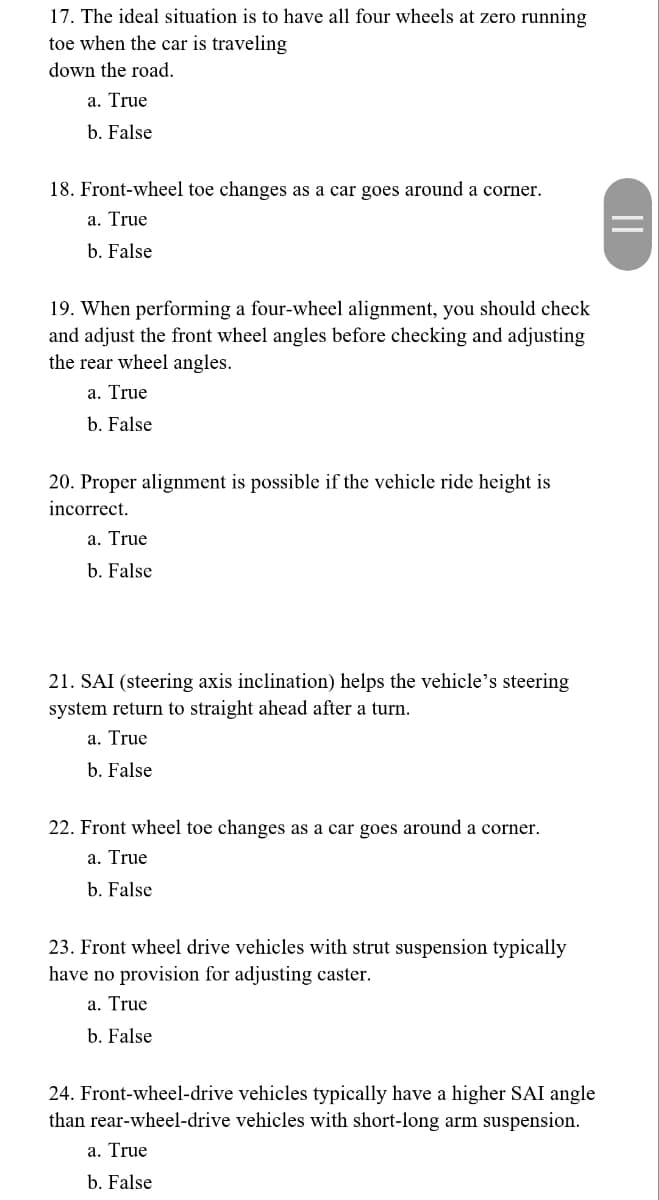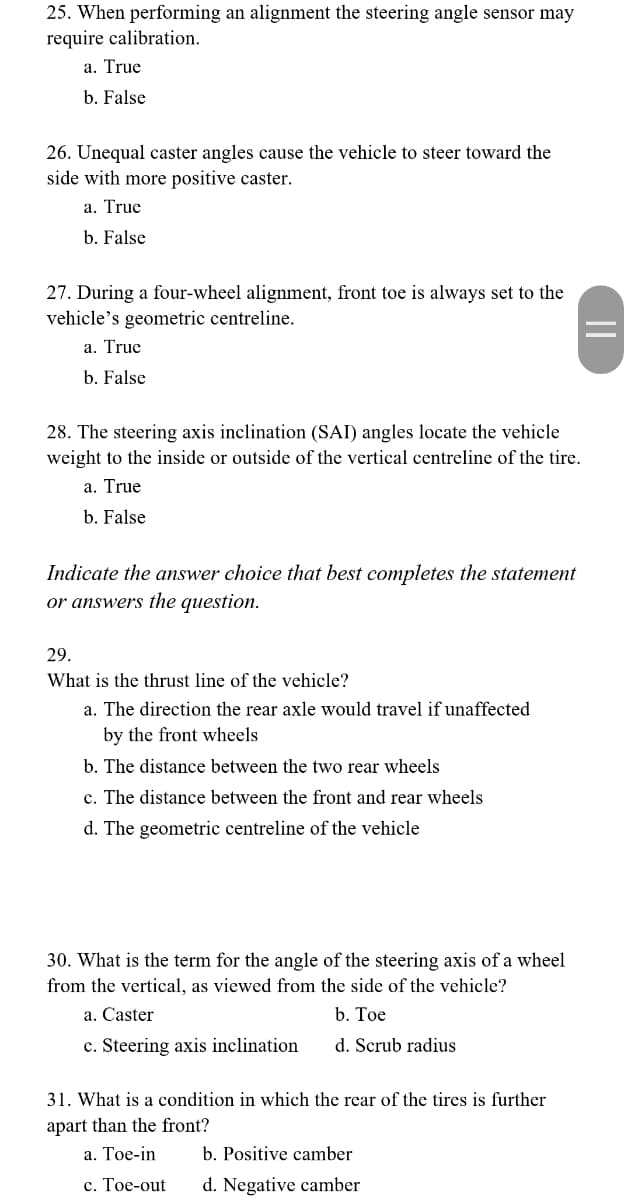17. The ideal situation is to have all four wheels at zero running toe when the car is traveling down the road. a. True b. False 18. Front-wheel toe changes as a car goes around a corner. a. True b. False 19. When performing a four-wheel alignment, you should check and adjust the front wheel angles before checking and adjusting the rear wheel angles. a. True b. False
17. The ideal situation is to have all four wheels at zero running toe when the car is traveling down the road. a. True b. False 18. Front-wheel toe changes as a car goes around a corner. a. True b. False 19. When performing a four-wheel alignment, you should check and adjust the front wheel angles before checking and adjusting the rear wheel angles. a. True b. False
Automotive Technology: A Systems Approach (MindTap Course List)
6th Edition
ISBN:9781133612315
Author:Jack Erjavec, Rob Thompson
Publisher:Jack Erjavec, Rob Thompson
Chapter45: Tires And Wheels
Section: Chapter Questions
Problem 14RQ: All of these statements about improper wheel balance are true except? a. Dynamic imbalance may cause...
Related questions
Question
Hello, I am trying to study for a test and found this practice review but I'd like to be able to check my work. Can someone help answer some of these questions? Thank you

Transcribed Image Text:17. The ideal situation is to have all four wheels at zero running
toe when the car is traveling
down the road.
a. True
b. False
18. Front-wheel toe changes as a car goes around a corner.
a. True
b. False
19. When performing a four-wheel alignment, you should check
and adjust the front wheel angles before checking and adjusting
the rear wheel angles.
a. True
b. False
20. Proper alignment is possible if the vehicle ride height is
incorrect.
a. True
b. False
21. SAI (steering axis inclination) helps the vehicle's steering
system return to straight ahead after a turn.
a. True
b. False
22. Front wheel toe changes as a car goes around a corner.
a. True
b. False
23. Front wheel drive vehicles with strut suspension typically
have no provision for adjusting caster.
a. True
b. False
24. Front-wheel-drive vehicles typically have a higher SAI angle
than rear-wheel-drive vehicles with short-long arm suspension.
a. True
b. False
||

Transcribed Image Text:25. When performing an alignment the steering angle sensor may
require calibration.
a. True
b. False
26. Unequal caster angles cause the vehicle to steer toward the
side with more positive caster.
a. True
b. False
27. During a four-wheel alignment, front toe is always set to the
vehicle's geometric centreline.
a. True
b. False
28. The steering axis inclination (SAI) angles locate the vehicle
weight to the inside or outside of the vertical centreline of the tire.
a. True
b. False
Indicate the answer choice that best completes the statement
or answers the question.
29.
What is the thrust line of the vehicle?
a. The direction the rear axle would travel if unaffected
by the front wheels
b. The distance between the two rear wheels
c. The distance between the front and rear wheels
d. The geometric centreline of the vehicle
30. What is the term for the angle of the steering axis of a wheel
from the vertical, as viewed from the side of the vehicle?
b. Toe
d. Scrub radius
a. Caster
c. Steering axis inclination
31. What is a condition in which the rear of the tires is further
apart than the front?
a. Toe-in
c. Toe-out
b. Positive camber
d. Negative camber
||
Expert Solution
This question has been solved!
Explore an expertly crafted, step-by-step solution for a thorough understanding of key concepts.
This is a popular solution!
Trending now
This is a popular solution!
Step by step
Solved in 2 steps

Knowledge Booster
Learn more about
Need a deep-dive on the concept behind this application? Look no further. Learn more about this topic, mechanical-engineering and related others by exploring similar questions and additional content below.Recommended textbooks for you

Automotive Technology: A Systems Approach (MindTa…
Mechanical Engineering
ISBN:
9781133612315
Author:
Jack Erjavec, Rob Thompson
Publisher:
Cengage Learning

Automotive Technology: A Systems Approach (MindTa…
Mechanical Engineering
ISBN:
9781133612315
Author:
Jack Erjavec, Rob Thompson
Publisher:
Cengage Learning